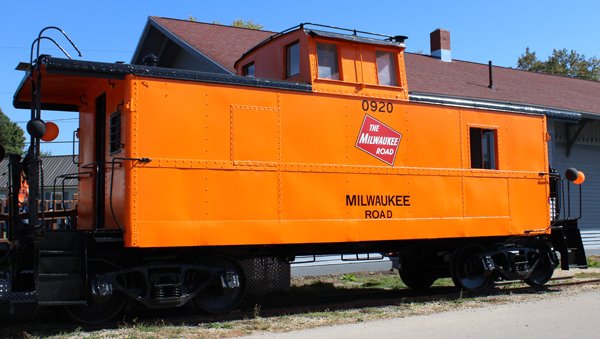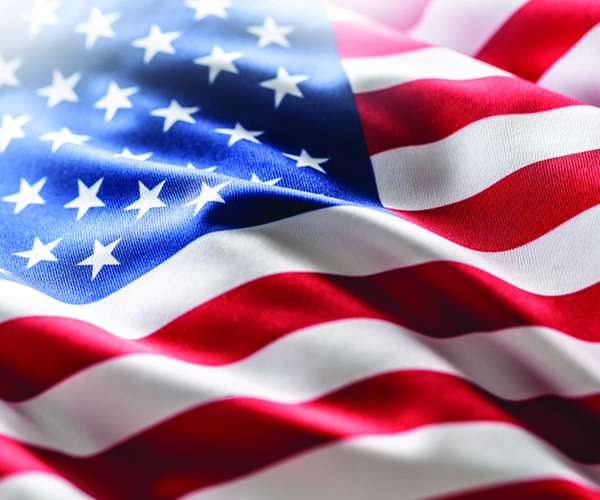

DARLINGTON — The long process of planning and restoration of a 1930s caboose was recently completed, resulting in a barrage of smiles last week.
The Lafayette County Historical and Genealogy Society, along with members of the Darlington Chamber/Main Street, all gathered in celebration alongside members of the community on Wednesday, Oct. 2 for the ribbon cutting ceremony of the 1930s Darlington Caboose.
The fully restored caboose stood stately beside the Darlington Depot in the bright autumn sunshine. The caboose, fashioned in Milwaukee Road orange, features a pot belly stove, a server’s desk, several working lanterns, vintage signal lanterns, and other railroad memorabilia. Everyone was given the opportunity to walk through the caboose, taking in the display as it was presented. Several spectators enjoyed the walk-through, stating how wonderful of an exhibit the caboose and its contents were.
“Thank you for coming today to celebrate the caboose,” said Darlington Chamber/Main Street Director Kristen May, addressing the crowd of those gathered. “Your support and presence are appreciated. I know it’s been a lot of work to get things done. Barb (Nemec), you have led this project, and we are all grateful. The caboose serves the entire community for something that everyone can enjoy.”
Nemec, Caboose Project Manager, also serves as the Museum Manager for the Lafayette County Historical and Genealogy Society.
“We are gathered in celebration, and we are grateful for the support from the Chamber and all of you,” Nemec said. “The windows were supposed to be in, but we are still waiting for those, other than that, we present you with the restored caboose. Have a look around. We are so happy for you to be here. This caboose isn’t just ours, please consider it to be yours too. It belongs to all of Darlington. There are refreshments for you to have. Please enjoy this beautiful day.”
Cake, caboose cookies, and an orange sherbet punch were enjoyed by those in attendance. More than 30 people gathered together to share stories, enjoy conversation, and dabble in the caboose’s history.
The early caboose structures were nothing more than a flat car with a small cabin attached to it. Since its early beginnings in the 1830s, railroads housed trainmen in the shanties built onto flatcars and boxcars. The train crew were hired to protect the rear of the train while stopped on the tracks. The caboose eventually advanced into the structures that are seen today.
Coal or wood was used to fire a cast-iron stove for cooking meals and heating up the structure. The stove had a flat surface with a ‘lip’ that would prevent pans from sliding off while the train was moving. The stoves were bolted to the floor of the caboose to gain stability and prevent accidental fires from starting. There was a safety feature of the double-latched door which prevented the discharge of hot coals, as caused by the constant rocking motion of the caboose while the train was moving.
A desk or table was provided in the caboose where the conductor kept records and handled business of the train, crew members, maps, and journeys taken. The caboose provided minimal living quarters, and was frequently personalized with items from home to prevent loneliness of the crew, especially on long distance trips.
Oil lamps provided light in the earliest of days, with electricity eventually replacing the oil versions. As time moved on, an electric generator was provided, driven by belts coupled to one of the axles on the caboose. This advancement assisted in the charging of electricity to a storage battery, and being able to light up the structure while the train was moving. This was essential in the dusk and nighttime hours. The red lights that were connected to the end of the caboose were used to display the end of a train, especially to those who may have found themselves on the tracks at the same time as the moving train.
The cupola, which is the second-story lookout post atop the caboose, wasn’t introduced to the railroad structures until 1863. The cupola made it possible for the crew to have an upper vantage-point to see clearly any threats to the train, such as shifted loads; broken, damaged and/or dragging equipment; overheated axle bearings; another locomotive; or structure damage to the tracks or train itself. It was the job of the entire crew to prevent derailment of the train, and the safety for all onboard.





